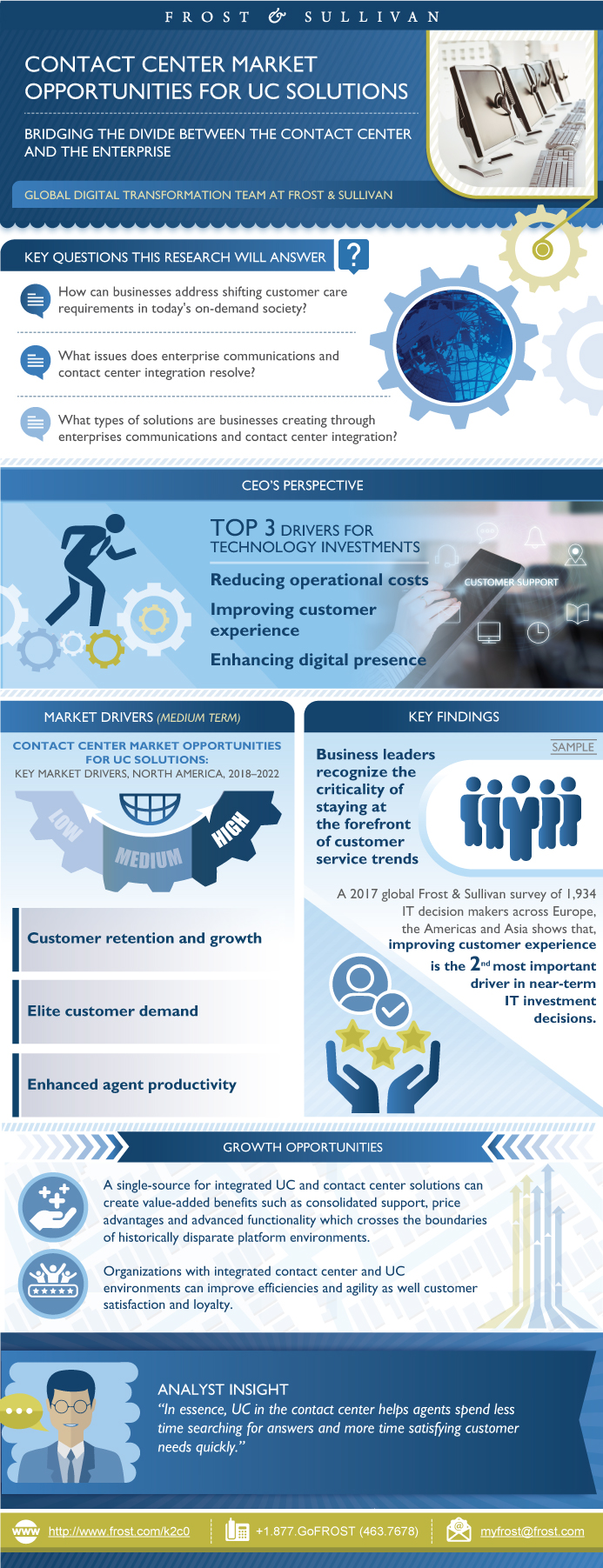Contact Center Market Opportunities for UC Solutions
Contact Center Market Opportunities for UC Solutions
Bridging the Divide Between the Contact Center and the Enterprise
23-May-2018
North America
$3,000.00
Special Price $2,250.00 save 25 %
Description
Call, contact or customer interaction centers have traditionally been walled off from the rest of the enterprise, with each organization utilizing separate and distinct platforms for most of their communications capabilities. The contact center has primarily needed to communicate with the outside world, with few requirements to interact in rich ways with co-workers located throughout their organization’s broader enterprise environment. As a result of differing needs, contact center and enterprise communications often have different decision makers, influencers, buyers and procurement cycles. At the same time, today’s customers are hyper-connected, impatient and prone to conduct the research needed to become knowledgeable about products and services before they buy. Prompt, complete and professional service is needed to answer increasingly in-depth and complex customer questions. Business leaders recognize the criticality of staying at the forefront of customer service trends. Organizations must become more agile and internally collaborative in response to rapid shifts in customer demand and market trends. A culture of an enterprise-wide customer service organization is where all employees focus on customer service and support in some fashion. Therefore subject matter experts (SMEs) and other resources within the broader enterprise must be available to assist contact center agents and supervisors. Leading providers are facilitating enterprise-wide customer support by integrating their enterprise communications and contact center applications. A single-source for integrated UC and contact center solutions can create value-added benefits such as consolidated support, price advantages and advanced functionality which crosses the boundaries of historically disparate platform environments. Both enterprise communications and contact center solutions are moving toward integrated multi-modal environments which address a wider range of employee and customer preferences, physical environments, devices and information sharing requirements. Enterprises recognize the ability to quickly implement and reap the benefits of communications capabilities consumed as a service. In a 2017 global Frost & Sullivan survey of IT decision makers, 37 percent listed access to advanced features/capabilities as a top-three benefit of cloud technology. An increasing number of companies want a single solution for their contact center and UC components and tools. In the same global 2017 Frost & Sullivan survey, 22 percent of IT decision makers state that a broad portfolio which allows for one-stop shopping is a key factor in choosing a cloud services provider. They aim to: simplify application adoption, purchasing, and support; reduce IT costs and latency when customer contacts shift between agents and channels. Service providers are answering the call with new deployment and consumption models that lower the barriers for organizations seeking more sophisticated customer care capabilities. The research service evaluates trends in demand and adoption of agile customer care solutions which are increasingly required for businesses to succeed in today's on-demand society.
RESEARCH: INFOGRAPHIC
This infographic presents a brief overview of the research, and highlights the key topics discussed in it.Click image to view it in full size

Table of Contents
Key Findings
Key Findings (continued)
Executive Summary—CEO’s Perspective
State of the Market
State of the Market (continued)
State of the Market (continued)
Market Definitions—Omni-channel Contact Center
Market Definitions—Unified Communications
Integrated Contact Center/Unified Communications Solution Types
Mass Migration to Multi-modal Solution Sets
Contact Center Interaction Channels—Current and Future Plans
Contact Center Plans for Integration
Market Trends—Factors Preventing Contact Centers from Meeting Goals
Average Contact Center Talk Time
Enterprise Communications and Collaboration Infrastructure Trends
Omni-channel Contact Center Strategy Challenges
Hybrid Premises-based/Hosted Environments
Access to New Capabilities
Unified Platforms
Ongoing Provider Consolidation
Market Drivers
Drivers Explained
Drivers Explained (continued)
Market Restraints
Restraints Explained
Restraints Explained (continued)
North America Contact Center Market Forecasts
North America Unified Communications Market Forecasts
Contact Center/UC Integration Solutions Overview
Contact Center/UC Integration Examples
Customer Reference—MyOutDesk Enhances Customer Relations with RingCentral
Customer Reference—Vivonet Optimizes Business with Genesys
Customer Reference—Sign Solutions Innovates with StarLeaf
Customer Reference—iCruise Sails Smoothly with 8x8
Customer Reference—Firefly Cuts Costs and Increases Efficiencies with Vonage
Strategic Recommendations for Vendors
Legal Disclaimer
List of Exhibits
Abbreviations and Acronym Used
Additional Resources
The Frost & Sullivan Story
Value Proposition—Future of Your Company & Career
Global Perspective
Industry Convergence
360º Research Perspective
Implementation Excellence
Our Blue Ocean Strategy
Popular Topics
| No Index | No |
|---|---|
| Podcast | No |
| Author | Nancy Jamison |
| Industries | Information Technology |
| WIP Number | K2C0-01-00-00-00 |
| Keyword 1 | Contact Center |
| Is Prebook | No |
| GPS Codes | 9526-C1,9528-C1,9610,9656,9661,9705-C1,9717-C3,9723,9724,99DF-C1,9A59-C1,9A5B-C1 |
 USD
USD GBP
GBP CNY
CNY EUR
EUR INR
INR JPY
JPY MYR
MYR ZAR
ZAR KRW
KRW THB
THB